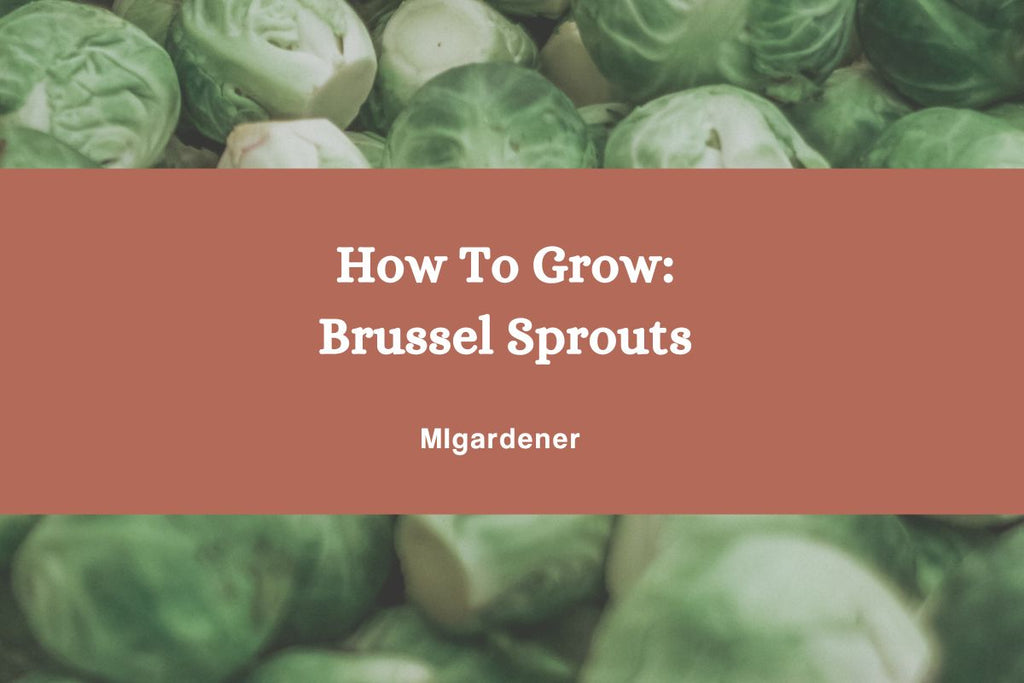
How to Grow: Organic Brussels Sprouts
Written by - Kaitlynn from MIgardener
Spring is just around the corner! This is the perfect time of year to brush up on your knowledge of growing techniques. Here at MIgardener, we want to share all of our favorite growing secrets; from our garden to yours. As you read through this post, you'll find there is nothing simpler than growing organic!
Brussels sprouts are one of the most stigmatized vegetables of all time. Because of how horrible they taste when cooked from frozen at the grocery store, they have become one of the worlds least favorite vegetables. This is unfortunate, because the transformation in flavor that happens when the sprouts are harvested fresh from the garden is magnificent. Grown fresh, these beautiful plants produce sweet and uniquely textured sprouts that are delicious brazed or grilled. Brussels sprouts are simple to grow at home, so why not give it a try?
Let's get started.
Soil Prep:
Soil should be rich with organic material, but loose enough to work with. Add a mixture of one part compost and one part sand to keep soil rich and well drained. Like broccoli, brussels sprouts are prone to a disease called club root. Club root attacks the root structure and causes it to deform into gnarly knots and nodules, which has a negative effect on the roots ability to uptake water and nutrients.
To prevent club root you must compress the soil where you want to plant, this removes air gaps that lead to the disease. Dig a trench approximately 2 inches deep and then lightly compress soil down with your foot or by pressing firmly with your hand. Soil should still be crumbly when moved, but have a noticeable density from the reduced air pockets. This is the same for any vegetable in the brassica genus like broccoli, cabbage, and cauliflower.
Fertilize:
Brussels sprouts require nitrogen rich fertilizer. It feeds twice a season to encourage the leaf growth needed to collect nutrients through photosynthesis. We apply Trifecta+ to the soil once before planting, and then a second time mid-season to boost the nutrients surrounding the plant. Even though Trifecta+ releases nutrients all season long, brussels sprouts are extremely intense feeders and require more attention in this area.
Ph Levels:
Alkaline soil is best for growing Brussel sprouts. 7-7.5 on an acidity test.
Sunlight:
Brussels sprouts need 5-7 hours of daily sun. The more sun your brussels sprouts get, the bigger the leaves will grow and the more sprouts it will produce. Full sun is especially important for the growth of the sprouts, after the defoliation process when there are less leaves to collect energy. More on that in the harvest section below.
Water:
Generally a 1/2 gallon or 1 inch of water per week for most climates, but the plant requires adequate soil moisture to begin with. Provide plants with consistent water for faster growth.
Spacing:
If Brussel sprouts are planted too close together, they will be in danger of rotting because of a lack of airflow. Space them 10-11 inches apart to give enough room to develop large leaves. This will also give you more space to harvest when the time comes.
Temperature:
This cold weather crop will germinate in any temperature from 45-85 degrees F. Brussels sprouts can be harvested well into December in northern climates because of its tolerance to cold temperatures.
Harvesting:
110-130 days to maturity. As the season progresses, sprouts will begin to form at the bottom of the plant first. Once the leaves begin to turn a little yellow, shock the plant by breaking them off. Break about a half an inch away from the base of the plant to prevent damaging it. This gives the sprouts more room to double in size during their development. This process if called defoliation.
Leave 2-3 inches of leaves at the top of the plant to keep it alive. This allows it to continue taking in nutrients from photosynthesis. Harvest brussels sprouts when the heads are firm and 1-2 inches in diameter. Each plant will yield between 60-100 sprouts. Harvesting in cooler weather (i.e. late fall) will produce crops with a milder sweeter flavor. The leaves are also edible and have a kale like texture and flavor.
This grow guide is based on videos from our youtube! Find more information about MIgardener on Instagram, Facebook, or on our website at MIgardener.com




Going to try brussels sprouts this year. Getting seeds from MI Gardener online.
Whenever I grow brussel sprouts, the plants get lovely tall with lots of leaves. The sprouts along the stem never close up to form a cabbage like ball and stay leafy. Not sure how I can get them to close up. Maybe the timing of defoliating the plant is wrong. I water, fertilize and am frustrated. I did note that someone mention on a youtube video that the aphids will get between the leaves which prevents them from closing. Without spraying chemicals on the plant, how do I prevent this?
Thanks for your feedback,
Alice
I’m very excited to try brussel sprouts again, going to follow your instructions. I’m so happy I found you. I love gardening and enjoy your videos.
Leave a comment